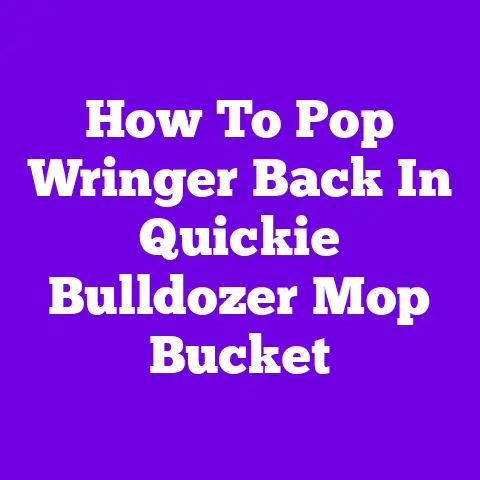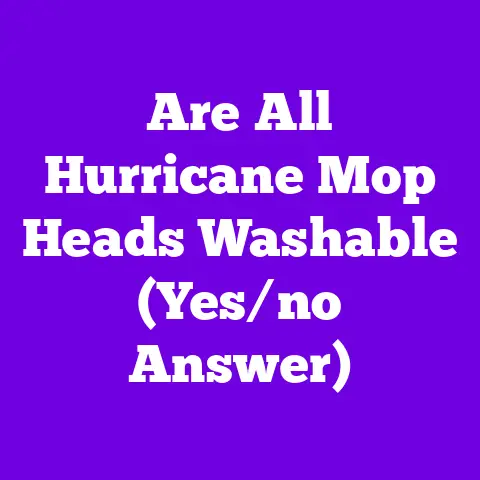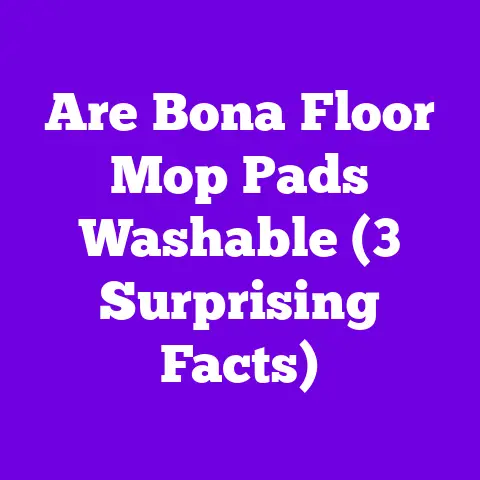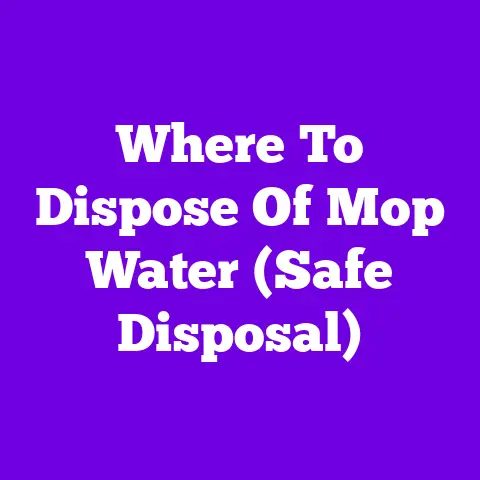Grimy Floors? Mop More Slowly for Best Results (Explained)
Keeping floors clean is an important part of maintaining a healthy home. However, when floors become extremely grimy, it can be tricky to get them fully clean. The key is to mop more slowly and thoroughly to allow time for the cleaning solution to break down the built-up dirt and grime.
Why Floors Get So Grimy
There are a few key reasons floors can become very dirty and grimy over time:
High Traffic Areas – Entryways, hallways, and other high traffic areas naturally collect more dirt as people and pets walk over them everyday. All this foot traffic tracks in outdoor dirt.
Spills & Messes – Food spills, dirt from shoes, grease, drink spills and more can leave sticky residue and stains on floors that build up over time.
Irregular Cleaning – When floors are only cleaned every so often, dirt, dust and grime builds up on the surface. This makes them appear much dirtier.
Improper Cleaning – Using the wrong type of mop, little cleaning solution, or not mopping thoroughly can lead to floors that appear clean but still have lingering dirt and build up.
Slow Down When Mopping Dirty Floors
Floors that are very grimy require a more thorough cleaning approach. The key is to mop more slowly and methodically to allow the cleaning solution time to break up the built-up messes.
When mopping floors that are very dirty:
- Use a strong cleaning solution – Choose a floor cleaner designed to cut through heavy dirt and grime. Stay away from diluted or mild solutions.
- Let solution sit – Allow cleaning solution to sit on floor for 3-5 minutes before mopping. This gives it time to start breaking down the messes.
- Mop in small sections – Only mop in 3×3 to 4×4 foot sections. This ensures you thoroughly clean each area before moving on.
- Make extra passes – Go over each section with several passes of the mop, applying pressure to scrub. More passes lifts more grime.
- Rinse & repeat – Rinse mop head frequently as it collects dirt. Re-wet and repeat process until water runs clear.
Taking this slow, thorough approach gives time for the cleaning solution to lift the grime so it can be removed, not just spread around.
Choose the Right Mop
Having the right mop makes a big difference when tackling extremely dirty floors. The best types of mops include:
Sponge Mops
- Absorbent sponge loosens and lifts dirt
- Washable sponge heads are reusable
- Avoid string mops – they just push grime around
Steam Mops
- Heat & steam loosens stuck-on grime
- Sanitizes floors with very hot steam
- Not as effective removing heavy build-up
Spin Mops
- Roller spins to scrub floors & remove grime
- Special heads designed for scrubbing
- More pressure lifts grime standard mops may leave behind
Hands & Knees
- Allows you to really scrub tough stains
- Reach areas appliances can miss
- Tough on your body for whole floor
Consider your needs and floor type to choose the best mop for grimy floors. The scrubbing action of a spin or hands & knees approach helps lift heavy grime.
Use a Strong Cleaning Solution
The cleaning solution you use is very important when tackling extremely dirty floors. You need an effective cleaner that can cut through layers of grime on the floor.
Key Ingredients to Seek Out
- Alkalis – Helps break down oils and greasy grime
- Solvents – Cuts through sticky and oily messes
- Surfactants – Lifts and surrounds grime to be removed
- Bleach – Removes stains and disinfects
- Acids – Help dissolve mineral deposits and soap scum
Avoid diluted or multi-surface cleaners. Look for heavy duty floor cleaner specifically designed for very dirty floors. Check label for key grime-fighting ingredients that suit your floor’s grime type.
Grimy Floor Cleaning Step-by-Step
Follow this detailed process when tackling extremely dirty floors:
1. Remove Surface Items
First, remove everything moveable from the floor – furniture, rugs, etc. This clears the space to mop thoroughly.
2. Vacuum Floor
Thoroughly vacuum the entire floor. This removes dry dirt and debris so mopping can focus on lifting grime. Get into corners and crevices.
3. Fill Bucket & Prepare Mop
In a mop bucket, mix very hot water and 2-4x the amount of heavy duty floor cleaner recommended on label. Soak mop head in solution to fully saturate.
4. Section Floor
Work on 3×3 to 4×4 foot sections at a time. Use tape to mark sections or work from walls inward. This ensures you fully clean each area.
5. Apply Cleaning Solution
Working section by section, use soaked mop to apply liberal cleaning solution over floor area. Avoid spreading to uncleaned sections.
6. Let Solution Sit 3-5 Minutes
Allow cleaning solution time to start breaking down heavy grime on floor. Set a timer and don’t let solution dry.
7. Scrub Section Thoroughly
Use mop, spin mop, or hands & knees to thoroughly scrub section. Apply pressure and make many passes to lift grime the solution loosened.
8. Absorb & Rinse Mop
Use mop to absorb lifted grime. Frequently rinse mop until water runs clear. Soak & wring thoroughly before reuse.
9. Repeat Process
Reapply solution and scrub until floor section is clean. Check with white glove – repeat process if glove shows grime. Scrub stubborn spots.
10. Let Floor Dry
Rinse floor section with clear water. Allow floor to completely dry before replacing rugs or furniture.
11. Inspect & Spot Clean
Inspect floor for any remaining sticky or glossy spots. Spot clean these areas with solution until floor looks uniformly clean.
Prevent Extremely Grimy Floors
While tackling very dirty floors takes time and elbow grease, preventing them is easier with good cleaning habits:
- Quick daily sweep, mop, or vacuum to prevent build up
- Weekly scrub floors with cleaning solution
- Spot clean spills quickly when they happen
- Deep clean seasonally twice per year
- Install mats at entryways and high traffic areas
- Remove shoes when entering to avoid tracking in dirt
- Consider no-shoes policy indoors
Establishing simple daily and weekly cleaning routines keeps dirt from building into extreme grime over time.
Grimy Floors FAQ
Still have questions about getting very dirty floors clean? Here are answers to some common grimy floor dilemmas:
What is the fastest way to clean extremely dirty floors?
While thorough cleaning is essential, you can save time by:
- Using a steam mop to loosen grime with heat
- Mixing super hot water & extra strength solution to cut grease
- Working in small sections to concentrate efforts
What homemade solution cleans grimy floors best?
Mix:
- 1 cup hot water
- 1⁄4 cup powder laundry detergent
- 1⁄4 cup powder oxygen bleach cleaner
- 2 tablespoons clear ammonia
How do you clean old grime that is stuck on?
For really stuck-on messes:
- Apply ice to harden gum, grease, wax
- Gently scrape with plastic scraper
- Use scrub brush and powdered detergent paste
What setting should I use on my steam mop?
For very dirty floors, use the highest steam setting. This allows very hot steam to penetrate and loosen thick grime. Be careful handling on high heat.
Why does my floor appear clean but is sticky?
Floors can seem clean but feel sticky because the grimy residue was spread around not lifted fully. Slow down and make more passes to remove cleaner and lifted grime fully.
What should I do if my floors get grimy again quickly?
Frequently grimy floors indicate an underlying issue. Troubleshoot root causes like leaky appliances, pets tracking in dirt, lack of entry mats, outdoor soil, etc.
In Closing
Extremely grimy floors can seem like a hopeless chore, but with some elbow grease and the right techniques they can get back to shiny and clean. Be sure to mop slowly in small sections, make multiple passes to lift grime, rinse frequently, and use the strongest solution for your floor type. Establishing preventive cleaning habits keeps floors from ever reaching an extremely grimy state.






